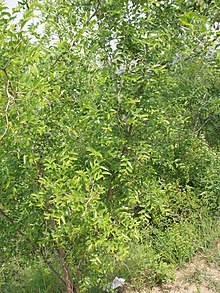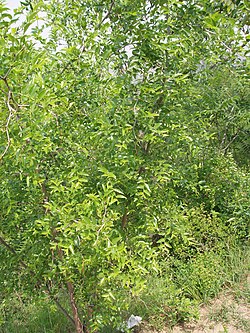Ziziphin
| Strukturformel | |||||||||||||
|---|---|---|---|---|---|---|---|---|---|---|---|---|---|
 | |||||||||||||
| Allgemeines | |||||||||||||
| Name | Ziziphin | ||||||||||||
| Andere Namen | Ziziphen | ||||||||||||
| Summenformel | C51H80O18 | ||||||||||||
| Externe Identifikatoren/Datenbanken | |||||||||||||
| |||||||||||||
| Eigenschaften | |||||||||||||
| Molare Masse | 981,17 g·mol−1 | ||||||||||||
| Sicherheitshinweise | |||||||||||||
| |||||||||||||
| Soweit möglich und gebräuchlich, werden SI-Einheiten verwendet. Wenn nicht anders vermerkt, gelten die angegebenen Daten bei Standardbedingungen (0 °C, 1000 hPa). | |||||||||||||
Ziziphin (auch Ziziphen)[2] ist ein Triterpen-Glycosid aus der chinesischen Dattel Ziziphus jujuba, das den Süßgeschmack auf der Zunge des Menschen hemmt.
Eigenschaften

Ziziphin kommt in den Blättern von Ziziphus jujuba vor.[3] Es hemmt den Süßgeschmack,[4] wie auch Lactisol,[5][6] Gymnemasäuren,[3] Gurmarin[3] und Hodulcine. Es wirkt schwächer[7] und kürzer als Gymnemasäuren.[8]
Literatur
- L. M. Kennedy, B. P. Halpern: Fly chemoreceptors: a model system for the taste modifier ziziphin. In: Physiology & behavior. Band 24, Nummer 1, Januar 1980, S. 135–143, PMID 7384237.
Einzelnachweise
- ↑ Dieser Stoff wurde in Bezug auf seine Gefährlichkeit entweder noch nicht eingestuft oder eine verlässliche und zitierfähige Quelle hierzu wurde noch nicht gefunden.
- ↑ Klaus Dürrschmid: Gustatorische Wahrnehmung gezielt abwandeln. Behr’s Verlag DE, 2009, ISBN 978-3-89947-970-6, S. 40.
- ↑ a b c Y. Kurihara: Characteristics of antisweet substances, sweet proteins, and sweetness-inducing proteins. In: Critical reviews in food science and nutrition. Band 32, Nummer 3, 1992, S. 231–252, doi:10.1080/10408399209527598, PMID 1418601.
- ↑ M. Sato: Sweet taste receptor mechanisms. In: The Japanese journal of physiology. Band 35, Nummer 6, 1985, S. 875–885, PMID 3914569.
- ↑ P. Jiang, M. Cui, B. Zhao, Z. Liu, L. A. Snyder, L. M. Benard, R. Osman, R. F. Margolskee, M. Max: Lactisole interacts with the transmembrane domains of human T1R3 to inhibit sweet taste. In: Journal of Biological Chemistry. Band 280, Nummer 15, April 2005, S. 15238–15246, doi:10.1074/jbc.M414287200, PMID 15668251.
- ↑ M. Zhao, X. Q. Xu, X. Y. Meng, B. Liu: The Heptahelical Domain of the Sweet Taste Receptor T1R2 Is a New Allosteric Binding Site for the Sweet Taste Modulator Amiloride That Modulates Sweet Taste in a Species-Dependent Manner. In: Journal of molecular neuroscience : MN. [elektronische Veröffentlichung vor dem Druck] August 2018, doi:10.1007/s12031-018-1156-5, PMID 30120716.
- ↑ A. D. Kinghorn, C. M. Compadre: Alternative Sweeteners (Third Edition, Revised and Expanded ed.) (2001). Marcel Dekker, New York. ISBN 0-8247-0437-1.
- ↑ V. V. Smith, B. P. Halpern: Selective suppression of judged sweetness by ziziphins. In: Physiology & behavior. Band 30, Nummer 6, Juni 1983, S. 867–874, PMID 6611691.
Auf dieser Seite verwendete Medien
chemical structure of ziziphin

